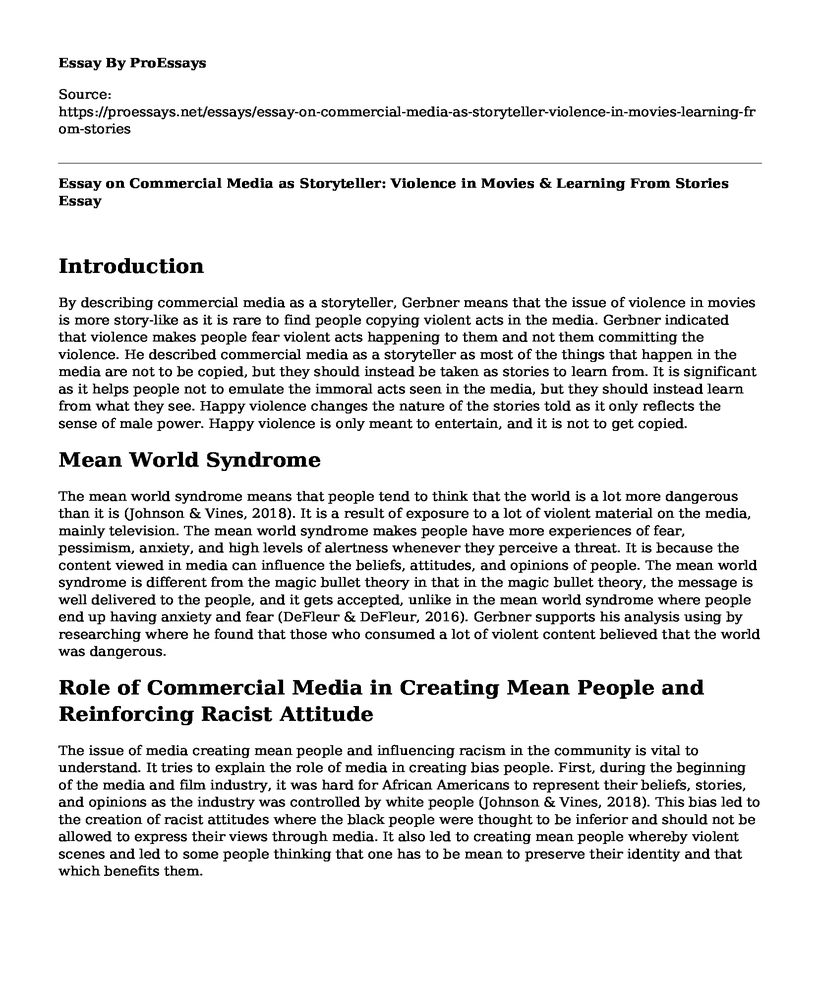Introduction
By describing commercial media as a storyteller, Gerbner means that the issue of violence in movies is more story-like as it is rare to find people copying violent acts in the media. Gerbner indicated that violence makes people fear violent acts happening to them and not them committing the violence. He described commercial media as a storyteller as most of the things that happen in the media are not to be copied, but they should instead be taken as stories to learn from. It is significant as it helps people not to emulate the immoral acts seen in the media, but they should instead learn from what they see. Happy violence changes the nature of the stories told as it only reflects the sense of male power. Happy violence is only meant to entertain, and it is not to get copied.
Mean World Syndrome
The mean world syndrome means that people tend to think that the world is a lot more dangerous than it is (Johnson & Vines, 2018). It is a result of exposure to a lot of violent material on the media, mainly television. The mean world syndrome makes people have more experiences of fear, pessimism, anxiety, and high levels of alertness whenever they perceive a threat. It is because the content viewed in media can influence the beliefs, attitudes, and opinions of people. The mean world syndrome is different from the magic bullet theory in that in the magic bullet theory, the message is well delivered to the people, and it gets accepted, unlike in the mean world syndrome where people end up having anxiety and fear (DeFleur & DeFleur, 2016). Gerbner supports his analysis using by researching where he found that those who consumed a lot of violent content believed that the world was dangerous.
Role of Commercial Media in Creating Mean People and Reinforcing Racist Attitude
The issue of media creating mean people and influencing racism in the community is vital to understand. It tries to explain the role of media in creating bias people. First, during the beginning of the media and film industry, it was hard for African Americans to represent their beliefs, stories, and opinions as the industry was controlled by white people (Johnson & Vines, 2018). This bias led to the creation of racist attitudes where the black people were thought to be inferior and should not be allowed to express their views through media. It also led to creating mean people whereby violent scenes and led to some people thinking that one has to be mean to preserve their identity and that which benefits them.
Real World Ramifications of Commercial Media
Media consumption has several ramifications on our collective consciousness. First, it is known to lead to cases of anxiety and depression. It is because one views the luxuries life of those in the media and wish they could achieve this as well. It leads to stress, and when one does not accomplish this, depression sets in. It also influences our ability to think critically about social problems as people tend to make judgments and decisions on a specific situation by basing it on what they saw in the media thinking the outcomes will be the same, which is not always the case. It also influences the ability of individuals to organize and develop practical solutions and responses to crime as it may provide vital information that can assist in coming up with policies to solve the problems of crime.
Evidence of Mean World Syndrome in Response To Crime
The police use the mean world syndrome as an asset to assist them in responding to crime. One scenario where it was used is when the police had to arrest a person that had been involved in several murders. The mean world syndrome assisted in solving the crime as people who were afraid that the person would kill them reported the issue to the police who were able to locate the criminal and arrested him (Bergan, & Lee, 2018). The mean world syndrome influenced the arrest as people did not want to leave with a serial killer in their neighborhood for fear that he would kill them.
References
Bergan, D., & Lee, H. (2018). Media Literacy and Response to Terror News. Journal of Media Literacy Education, 10(3), 43-56. Retrieved from https://eric.ed.gov/?id=EJ1194045
DeFleur, M. L., & DeFleur, M. H. (2016). The "magic bullet" theory of uniform effects. In Mass Communication Theories (pp. 144-154). Routledge.
Johnson, B. C., & Vines, J. E. (2018). It's Mad, Mad, Mad World: Mean World Syndrome (Media Effects). In Reel Big Bullies (pp. 36-42). Brill Sense.
Cite this page
Essay on Commercial Media as Storyteller: Violence in Movies & Learning From Stories. (2023, Mar 26). Retrieved from https://proessays.net/essays/essay-on-commercial-media-as-storyteller-violence-in-movies-learning-from-stories
If you are the original author of this essay and no longer wish to have it published on the ProEssays website, please click below to request its removal:
- Alexey Brodovitch Biography - Research Paper Example
- Essay Sample on Debate Over Immigration
- Illicit Drug Use Should Be Illegal in the US - Essay Sample
- Connor's Parents Dismissed for Failing to Exhaust Claims Under IDEA - Essay Sample
- Alcohol, Drug Abuse, Crime: A Closer Look - Essay Sample
- Paper Sample on Exploring Social Determinants of Health in Botswana
- Free Essay Example: Facebook's Controversial Privacy Policies and Impact on Emotions







